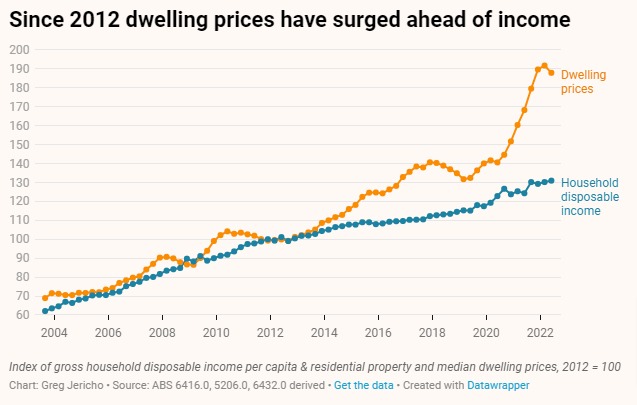Since the Reserve Bank began raising interest rates in May, the housing market has very much come off the boil.
But while the latest data from the ABS shows prices fell on average 2% across the nation in the June quarter, policy director Greg Jericho notes in his Guardian column that price remains well above what they were prior the pandemic.
During the GFC the majority of the stimulus measures directed towards construction were on public works – most notably the Building the Education Revolution. During the pandemic, however, the Morrison government targeted the housing market with its HomeBuilder program in conjunction with the Reserve Bank’s cutting interest rates. These served to set fire to the market as prices soared and affordability plummeted.
In June 2020, the average dwelling price in Australia was $689,400. That was around 13.4 times the average annual household disposable income of $51,487. Now the average household disposable income is up to $56,129, while the average dwelling price is now some 16.4 times that at $921,500.
Even worse, ten years ago the average dwelling price was just 11.4 times.
Housing policy has for too long been driven by keeping prices rising, and combined with flat income growth, it has seen a generation of Australians left out of the housing market.

You might also like
Analysis: Will 2025 be a good or bad year for women workers in Australia?
In 2024 we saw some welcome developments for working women, led by government reforms. Benefits from these changes will continue in 2025. However, this year, technological, social and political changes may challenge working women’s economic security and threaten progress towards gender equality at work Here’s our list of five areas we think will impact on
The 9 to 5 is back! Time to put the phone on silent
If you’ve ever flicked off an email before bed, texted your boss out of hours, or received an ‘urgent’ work call after clocking off, you’ll be glad to hear some respite is just around the corner. A new right to disconnect from work, for employees in businesses with 15 or more staff, comes into force
Productivity is often mistaken for wages. What does it really mean? How does it work?
Australia’s productivity growth has reverted to the same stagnant pattern as before the pandemic, according to the Productivity Commission’s latest quarterly report. Productivity is complex and often misunderstood in media and policy debates. So before we read too much into this latest data, here are six key things to understand about productivity. 1. It’s about quantities,


